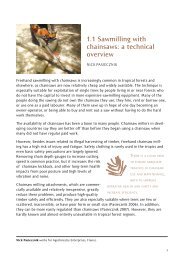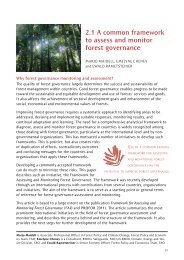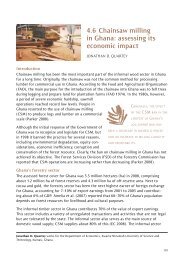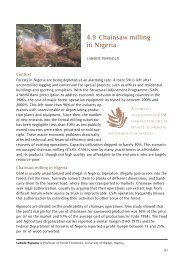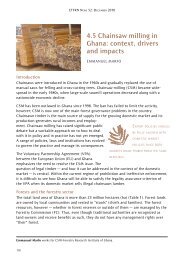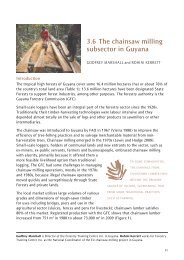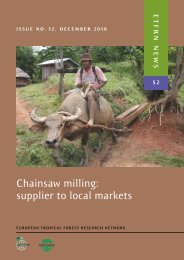Chainsaw milling: supplier to local markets - European Tropical ...
Chainsaw milling: supplier to local markets - European Tropical ...
Chainsaw milling: supplier to local markets - European Tropical ...
Create successful ePaper yourself
Turn your PDF publications into a flip-book with our unique Google optimized e-Paper software.
146<br />
ETFRN NEws 52: DEcEmbER 2010<br />
chainsaw <strong>milling</strong> in DRc: the challenges<br />
Demographic challenges<br />
The population of the DrC was estimated <strong>to</strong> be 69 million in 2010, with very high densities<br />
along the borders with uganda, rwanda, burundi (more than 100 inhabitants per<br />
km 2 ) and angola. with per capita GDp estimated in 2008 at us$156.6 (unDp 2009) this<br />
population pressure is exacerbated by the presence of refugees and uncontrolled armed<br />
elements that cause the loss of forest cover and will ultimately reverse any development.<br />
several studies 4 report the negative impact of Csm activities, especially those related <strong>to</strong><br />
subsistence agriculture. The mobilization of the active layers of the population in logging<br />
operations causes a decline in agricultural production. Thus, as noted by pax Christi<br />
(2007), Csm activities cause people <strong>to</strong> be hungry, because all active hands are used in<br />
forestry.<br />
Ecological challenges<br />
The combined effect of unsustainable logging, the introduction of chainsaws (in the<br />
mombasa area the number of chainsaws varies between 200 and 300) and the <strong>local</strong><br />
perception that forest resources are infinite, has resulted in habitat degradation. some<br />
people say “la forêt est rasée” (the forest is plundered). Csm, as a newly introduced<br />
technique and accessible <strong>to</strong> <strong>local</strong> communities, provides an opportunity <strong>to</strong> change from<br />
unsustainable logging techniques <strong>to</strong> modern operating standards respecting minimum<br />
logging diameters, CiTEs species and principles of sustainable management.<br />
Governance challenges<br />
The main governance challenges are the regularization of Csm and the traceability of<br />
wood.<br />
Regularization<br />
The forestry code, the legal basis of the sec<strong>to</strong>r, does not mention Csm specifically.<br />
The code notes Csm only in articles 112 and 113, which deal with the exploitation of<br />
community forests and which require the forest manager <strong>to</strong> seek approval from the state.<br />
observers of Congolese forest legislation are split on this issue:<br />
• some people think it is detrimental <strong>to</strong> communal forest managers, whose importance<br />
<strong>to</strong> the economy is not yet apparent; and<br />
• some people think the legislation is realistic since there is no control over this<br />
category of forest managers, and regula<strong>to</strong>ry authorities, who are better aware of the<br />
problems in the sec<strong>to</strong>r, should be responsible for the appointment of appropriate<br />
organizations.<br />
at the same time, regulation no. 035/Cab/min/ECn-EF/006 of 5 oc<strong>to</strong>ber 2006, which<br />
follows the new Forest Code, contains provisions for the approval of forest exploitation<br />
and <strong>local</strong> cutting permits.<br />
The current law recognizes only one category of chainsaw millers (pit-sawyers), while the<br />
trade chain also involves sawyers, retailers, firewood traders, mill owners and log trans-



